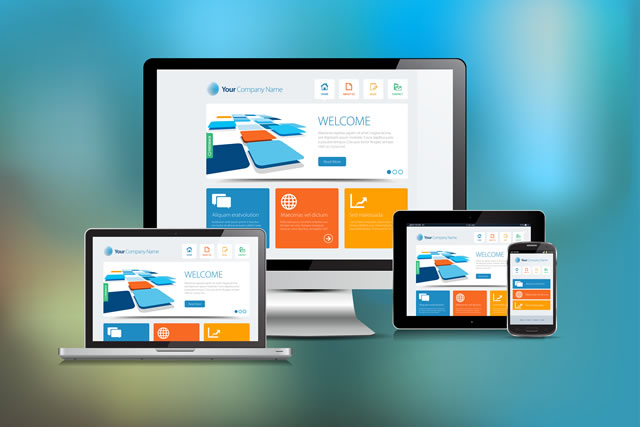RESPONSIVE WEB DESIGN
Author: Goran Cvijetic - *nbgteam
The information that the use of the Internet via mobile phones and tablets is on the rise is probably not a surprise. Maybe you practice the same thing yourself. According to our experience as well as research by renowned agencies, the use of the Internet via mobile devices reached the classic use via desktop or laptop computers in 2014.

Only a small number of companies have realized that they have to adapt to the development of new technologies. The first responsive websites (adapted website design) were used by web portals that deal with publishing news, because through analytics they had an insight into the sudden increase in such visits. We are witnessing the use of the telephone at every step, especially in moments of leisure. People use phones on the bus, in bars while waiting for someone, in parks, etc. You can easily get information on the percentage of visits from mobile devices on various web news portals if you ask them to send you an offer for advertising.
However, the vast majority of business sites still ignore this fact, and their sites are not adapted for mobile devices. This way, they refuse a certain percentage of visits due to the unsuitability of the site and the speed of loading, and thus risk losing business opportunities.
Development and design of responsive website pages
There are two main approaches to creating a responsive website.
The classic responsive web page design, which uses HTML5 and CSS3 programming languages, is applied by encoding the pages in a way that adapts to the screen resolution independently of the visitor's device. The elements of the page are coded in percentages, so the content is adjusted to the resolution of the visitor's screen.
Another way to adapt the site to mobile devices is to create separate template pages (mobile pages). Then the code for recognizing the resolution of the visitor's screen is placed on the site, and accordingly the visitor is redirected to the custom pages of the site.
Mobile pages or responsive web design
From the design point of view, the classic responsive web approach is more demanding, considering that the web designer should keep in mind different resolutions, and after the creation, a lot of testing and additional customization is required. This approach, given the requirements for page loading speed, implies simplicity, or reduced minimalist website design.
The special design and construction of mobile pages provides much more space and design freedom. In this case, a completely independent graphic design is done. Desktop pages are designed separately from mobile pages.
Which approach is better from the point of view of users and site owners?
It is difficult to answer this question by simply comparing the disadvantages and advantages. Choosing an approach primarily depends on the type of website and the content displayed. For small presentation sites, responsive web design is recommended, provided that the page design is reduced to a minimalist one. While for portal-type sites, it is recommended to create independent mobile pages because those pages can have reduced content. Therefore, in both cases, the decisive factor is the loading speed of the pages, considering that the speed on mobile devices is lower; the user's costs should be taken into account (flow in megabytes).
Responsive website design from the standpoint of search engine optimization (SEO)
We have already mentioned that one of the main reasons for the emergence of responsive web design is the development of technology, i.e. the emergence of mobile and tablet devices. Internet browsers are adapting accordingly.
In June 2012, Google representatives announced that this search engine preferred a responsive web page design approach to a separate mobile site design approach, due to the uniqueness of the website URL. Definitely most of the portals that created the mobile version of the site on a sub domain (usually mobile.domain.com or m.domain.com) made a mistake from the search engine optimization point of view. However, today Google recognizes and treats these pages separately (mobile sitemap) and is actually a basic error of some sites to place these pages on the sub domain.
On the other hand, the application of HTML5 programming language brings a number of advantages from the search engine optimization point of view, which will be discussed in the next article.
Use of mobile devices to search the Internet
If you still ignore the need to adapt the site to mobile devices, then these numbers will surely change your opinion:
- Over 20% of all Google searches are done on mobile devices. For some activities, the search is over 50%.
- 60% of people have a much better opinion of the brand when they have had a good experience visiting its site via mobile phone.
- Over 25% of all emails are sent via mobile phones and over 10% via tablets.
A positive user experience is the key advantage of responsive website
According to Google research, when your site loads slowly or the content is not adapted and clear, frustrated visitors via mobile phone will immediately leave your site and go to another. According to Google, this happens in 61% of cases. And in 67% of cases, when it comes to a positive experience, the chances are higher that the visitor decides to buy the product or use the service.
Social networks are increasing the number of mobile users
When social networks are included in the market strategy, visits via mobile devices increase drastically. According to research, 55% of the use of social networks takes place on mobile phones.
In this regard, if your site is not adapted for mobile phones, increased mobile traffic due to social media appearances, can lead to a high bounce rate, low conversion rate (visit = purchase) and finally to increased frustration and user dissatisfaction.
Responsive websites are the present but also the future
The main advantage of responsive web design is adjusting the screen resolution of the device. So, it’s very simple. In the future, advancement of technology and the emergence of new devices that will use the Internet (TV, watches, glasses ...) will not affect the display of your site. It will continue to be adaptable and acceptable to visitors and potential clients.
Today already, and even more in the future, the use of various technologically advanced devices for Internet search is growing. Simply, your appearance on the Internet must follow the progress of technology. It is incomprehensible that the vast majority of companies still do not attach special importance to internet appearance, so their sites are outdated, and they do not publish new content for months, even years. In fact, companies usually set up a presentation site, and that's it. Until the problems make them to make a new one.
All of the above clearly indicates that the neglect of technological development leads to a decline in business and sales. But on the other hand, for conscious companies, it is a chance that arises. It is an opportunity to stand out from the competition.
Find out how we do it and sign up for responsive web design services.
-

STARTING AN ONLINE BUSINESS
Targeted advertising is a big advantage of online business. New markets and accelerated development ...
-

HISTORY OF ONLINE SHOPPING
The first online shop was introduced by the Pizza Hut company...
-

PRIVATIZATION OF INTERNET SPACE
Novak Djokovic is really the best Serbian brand and promoter of our country ...
-

WHY MUST YOU HAVE AN ONLINE SHOP?
With our help, the design, architecture, content and development of the online store goes fast ...

 Viber
Viber

 Pozovite nas
Pozovite nas
Comments